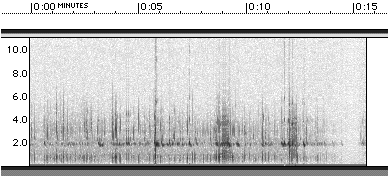 [Tweeks
result when sferics are ducted in the earth-ionosphere waveguide distances
much greater than a cuple of thousand kilometers. The distance can be as
great as halfway around the earth (20,000 kilometers). When ducted over
large distances, the VLF radio waves undergo a process called dispersion
- that is the higher frequencies travel slightly faster than the lower
frequencies. This is especially true of the frequencies between 3 and 2
kilohertz. Tweeks sound much different than sferics. Instead of the sharp
crackling sound, tweeks have a quick mujsical sound somewhat like the ricochet
sound bullets make (at least in the movies). The spectrogram of a tweek
shows a vertical line at the higher frequencies with a curved section (called
the "hook") appearing at a frequency of about 2 kilohertz.]
[Tweeks
result when sferics are ducted in the earth-ionosphere waveguide distances
much greater than a cuple of thousand kilometers. The distance can be as
great as halfway around the earth (20,000 kilometers). When ducted over
large distances, the VLF radio waves undergo a process called dispersion
- that is the higher frequencies travel slightly faster than the lower
frequencies. This is especially true of the frequencies between 3 and 2
kilohertz. Tweeks sound much different than sferics. Instead of the sharp
crackling sound, tweeks have a quick mujsical sound somewhat like the ricochet
sound bullets make (at least in the movies). The spectrogram of a tweek
shows a vertical line at the higher frequencies with a curved section (called
the "hook") appearing at a frequency of about 2 kilohertz.]
Tweeks seams to be a kind of sferics, with a sound like a small kind of whistler. Except from whistlers tweeks were produced in very high parts of the upper ionosphere and the sounding will arise due to strong multi-refelxions inside the single layers.
A normal tweek is between 0.1 and 0.3 S. and starts at around 6 kHz. His sound decrease is very importand till up 2 kHz and runs slow towards 1.5 kHz.
Tweeks were modified forms of lightning sferics and are electromagnetic impulses. These impulses undergoes a process of dispersion. The reproduced sound of a tweek sounds like chirp or tweek. The observed dispersion is a result from the interaction of the energy wave, the magnetic field and the ozon layer (round 60 km).
It is propable that tweeks are scattered sferics, which arive at the observer some later than sferics, due to extreme reflexions. Tweeks could be measured mainly during the nighthours, when the D-layer is recombinated. During the daytime the D-layer is so active that tweeks could not run through the D-layer normaly. The signal strength of a tweek is some weeker than from a sferic, measurements in the Hamburger Hallig during the 1970‘s showed. Some more measurements show that tweeks seams to be scattered between the D-Layer and the E-Layer or between the E-Layer and the ground.
References:
/1/ W.Schippke, Die Veränderung der Empfangsfeldstärke im VLF Bereich unter 20 kHz in Abhängigkeit vom Wetter entlang der Beobachtungsstrecke, MUMET Report, 1983, März Heft, Seite 12-16
/2/ G.Mattern, Der Anteil der Tweeks an Radio-Noise der Atmosphäre, in Kleinheubacher Berichte, Band 14, 1971, Seiten 323-325 (FTZ Darmstadt)
/3/ W.Becker, W.Schippke, ELF and ULF Reflexion between
the Ionosphere and the Ground, Telebild, 1991